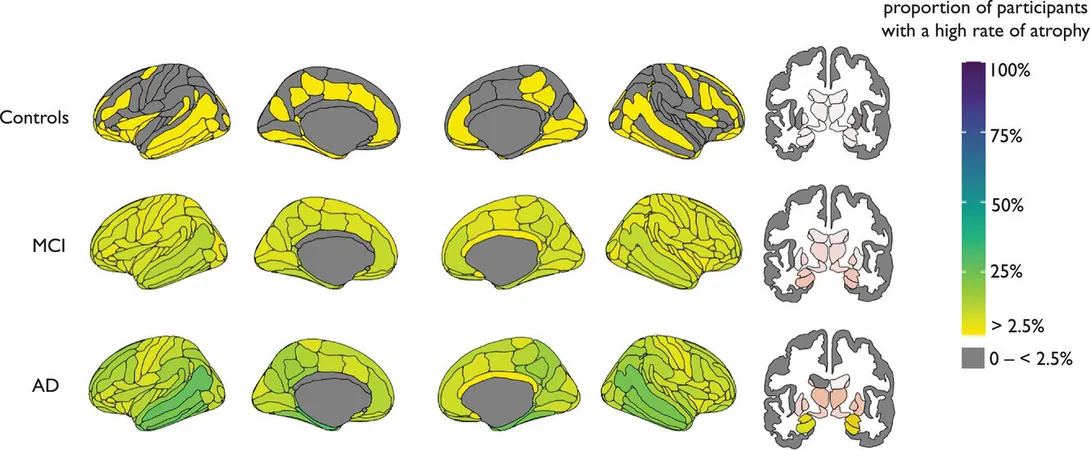
Breakthrough Study Reveals Unpredictable Patterns of Brain Shrinkage in Alzheimer’s Disease
2024-10-04
Introduction
A groundbreaking study conducted by researchers at UCL and Radboud University in the Netherlands has uncovered that the shrinkage of the brain in individuals diagnosed with Alzheimer’s disease does not adhere to a uniform or predictable pattern. This revelation, published in the journal Alzheimer's & Dementia, marks a significant advancement in understanding how Alzheimer's disease manifests in different individuals.
Study Overview
The study stands out as the first to track and compare the individual trajectories of brain shrinkage in individuals with mild memory problems or Alzheimer’s, against a benchmark derived from healthy subjects. This innovative method involved assessing brain scans for distinctive changes or "fingerprints" associated with the progression of the disease.
Key Findings
Researchers discovered that individuals experiencing mild memory issues who displayed a greater number of abnormal brain changes at a quicker pace were more likely to develop Alzheimer’s. An "outlier" is identified as a specific brain region that has experienced more shrinkage than what is typical for a person’s age and sex.
Importantly, the findings highlighted that while some overlap exists in shrinkage patterns among patients, there is no consistent shrinkage profile across different patients diagnosed with Alzheimer's. This variability suggests the need for tailored treatment approaches that consider the specific brain regions affected in each individual.
Expert Insights
Professor Jonathan Schott from UCL, a prominent figure behind the study, echoed this sentiment: "Alzheimer's affects everyone differently. Recognizing this variability is crucial for enhancing clinical trial designs and for developing customized patient treatment plans."
Context and Significance
Alzheimer's disease is recognized as the leading cause of dementia, accounting for 60% to 80% of all dementia cases, which affects approximately 944,000 people in the UK alone. Previous research conducted at a group level had established that patients with Alzheimer’s exhibit excessive brain shrinkage relative to healthy individuals, measurable by MRI scans. However, these studies often overlooked the individual variances in shrinkage patterns, potentially masking vital insights related to cognitive function changes over time.
Research Methodology
To tackle this issue, UCL researchers employed a normative modeling approach utilizing data from the Alzheimer's Disease Neuroimaging Initiative (ADNI). They meticulously analyzed 3,233 MRI brain scans from 1,181 patients with Alzheimer’s or mild memory issues, comparing them against data from 58,836 healthy individuals. The scans, taken mostly at annual intervals, were processed with specialized imaging tools assessing the brain's structural integrity across 168 distinct areas.
Results and Trends
The results revealed that although most participants began with similar brain sizes, their shrinkage patterns differed significantly over time. By the end of the study, patients with Alzheimer’s averaged around 30 outlier regions, compared to mild memory issue patients who saw only a modest increase from about 5 to 10, to an average of 8 outliers.
This research also unveiled an intriguing correlation between the number of outlier regions and cognitive performance: a higher number of outlier regions was linked to poorer memory recall in both groups. Moreover, individuals with mild memory issues who progressed to Alzheimer’s within three years developed an alarming four new outlier areas each year; a stark contrast to those who maintained only mild issues, who added less than one new outlier annually.
Future Implications
The findings pave the way for developing predictive models that could indicate the progression of Alzheimer's based on early brain changes identified on scans. However, researchers acknowledge the necessity for further investigation to dissect which changes forecast specific future symptoms.
Senior author, Professor James Cole, emphasized that the lack of a singular shrinkage pattern in Alzheimer's patients can be effectively utilized to monitor how brain structure influences symptom development and progression. The ultimate goal is to improve accuracy in diagnosis and treatment, tailoring interventions to the individual needs of patients.
Cognitive Decline and Variability
As people age, they inevitably face some degree of cognitive decline, and the study noted overlapping patterns of brain shrinkage between healthy individuals and those with memory impairments, particularly in regions critical for memory and cognitive function, like the hippocampus and other areas of the medial temporal lobe.
Conclusion and Future Research
Dr. Serena Verdi, the study's lead author, pointed out the importance of considering individual variability: "While certain brain regions, such as the hippocampus, are crucial in Alzheimer's, we must not fixate on these regions alone. Our findings illustrate that the areas affected can be vastly different from one person to another."
This comprehensive study significantly alters our understanding of Alzheimer’s disease and paves the way for a more personalized approach to diagnosis, monitoring, and treatment. The future of Alzheimer’s research is now focused on harnessing those individual variances, ultimately improving care for millions affected by this devastating condition.
Stay Updated
Stay tuned for more updates as researchers uncover new insights in the battle against Alzheimer’s disease!









 Brasil (PT)
Brasil (PT)
 Canada (EN)
Canada (EN)
 Chile (ES)
Chile (ES)
 España (ES)
España (ES)
 France (FR)
France (FR)
 Hong Kong (EN)
Hong Kong (EN)
 Italia (IT)
Italia (IT)
 日本 (JA)
日本 (JA)
 Magyarország (HU)
Magyarország (HU)
 Norge (NO)
Norge (NO)
 Polska (PL)
Polska (PL)
 Schweiz (DE)
Schweiz (DE)
 Singapore (EN)
Singapore (EN)
 Sverige (SV)
Sverige (SV)
 Suomi (FI)
Suomi (FI)
 Türkiye (TR)
Türkiye (TR)